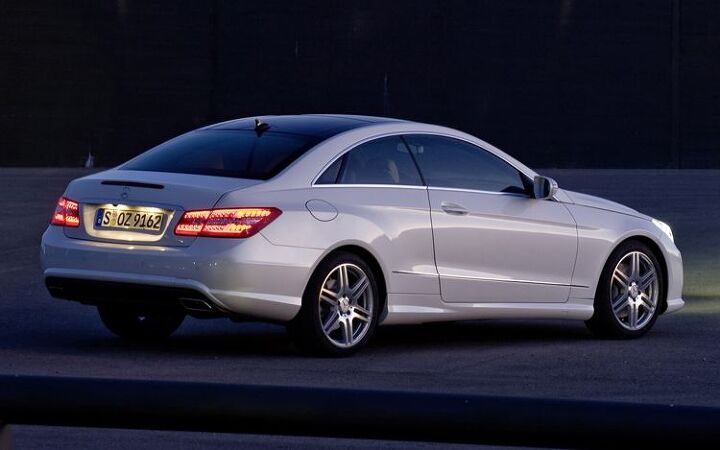The Truth About The 2010 Mercedes E-Class Coupe's Aerodynamics

This is a short story of how we sometimes arrive at the truth. Letting go of deep-seated childhood emotional responses is hard. Growing up in the fifties in Austria, Mercedes was my true God. My father had a friend with a 300 SL Gullwing, and I spent hours walking around it, absorbing each detail. There was an old Tatra streamliner in the neighborhood. Aerodynamics, efficiency, and speed are my triggers. In 1985, I bought one of the first W124 300E sedans in LA, in part because its Cd. of .28 was the best in the world then, as well as its 140 mph top speed. Just yesterday, in Part 3 of the History of Automotive Aerodynamics, I concluded the survey of current production car aerodynamics record-holders with the 2010 Mercedes E-Class coupe, honoring its widely disseminated Cd of .24, lower than even the 2010 Prius. Looking at the picture of that E Class coupe this morning triggered a totally unexpected upsurge of that old lust, something that I thought was long extinguished, and I actually went to the Mercedes web site for strictly personal reasons. I expected that Mercedes would be trumpeting the coupe’s .24 Cd proudly. Not so, and for a good reason.
In fact, there was no reference to it anywhere. I remember how proudly Mercedes was of the W124’s sleekness in its ads and brochures. What gives? I had to download a pdf with technical specs, and there it was, buried in small print: Cd of .28. It’s 1984 all over again.
I found the answer buried deep on Mercedes’ German web site: the .24 Cd only applies to the E 220 CDI Blue Efficiency model, that isn’t even going to be available until later this spring, and in then in Europe only. It must be lowered and have lots of aerodynamic tweaks. Google “Mercedes E-Class Coupe coefficient of drag”, and you’ll see that every magazine, web site, newspaper and of course wikipedia has repeated Mercedes’ Cd of .24 virus endlessly.
I’m still surprised with that unexpected surge of Mercedes lust; but it came for a reason: I’m totally over Mercedes now, and I’m here to proclaim to whoever listens: the 2010 Mercedes E-Class coupe has a Cd of .28, the same as a 2001 Camry, a 1995 Mitsubishi Diamante, a 2003 Saab 9-3, and a 1998 Chrysler Concorde.

More by Paul Niedermeyer
Latest Car Reviews
Read moreLatest Product Reviews
Read moreRecent Comments
- DesertNative More 'Look at me! Look at me!' from Elon Musk. It's time to recognize that there's nothing to see here, folks and that this is just about pumping up the stock price. When there's a real product on the ground and available, then there will be something to which we can pay attention. Until then, ignore him.
- Bkojote Here's something you're bound to notice during ownership that won't come up in most reviews or test drives-Honda's Cruise Control system is terrible. Complete trash. While it has the ability to regulate speed if there's a car in front of you, if you're coasting down a long hill with nobody in front of you the car will keep gaining speed forcing you to hit the brakes (and disable cruise). It won't even use the CVT to engine brake, something every other manufacturer does. Toyota's system will downshift and maintain the set speed. The calibration on the ACC system Honda uses is also awful and clearly had minimum engineering effort.Here's another- those grille shutters get stuck the minute temperature drops below freezing meaning your engine goes into reduced power mode until you turn it off. The Rav4 may have them but I have yet to see this problem.
- Sobhuza Trooper "Toyota engineers have told us that they intentionally build their powertrains with longevity in mind."Boy, that's pretty hateful. I suppose some greedy people who would pick Toyota would also want to have greater longevity for themselves. But wouldn't we all rather die at 75, while still looking cool than live to be 85 and look like a doddering old man?
- Kwik_Shift_Pro4X Neither. They're basically the same vehicle.
- Analoggrotto 1. Kia Sportage2. Hyundai TucsonRugged SUVs which cater to the needs of the affluent middle class suburbanite which are second only to themselves, these are shining applications of Hyundai Kia Genesis commitment to automotive excellence. Evolving from the fabled Hyundai Excel of the 90s, a pioneering vehicle which rivaled then upstart Lexus in quality, comfort and features long before Hyundai became a towering king of analytics and funding legions of internet keyboard warriors.


































Comments
Join the conversation
Be gentle, people; you're talking about my next ride. I've penciled in a 2010 E350 when they start coming off lease in 2013. Snow white, please, although I have a pea-green one spotted and I'm keeping an eye on it. Local dealer has my number and my requirements: The first one that hits my $27,500 price point wins. Never seen a body shop, all service records, still under a long warranty. I have no deal-breaker "must have-don't want" options.
I'd also give the E-Class coupe a thumbs-down vote. If this were a Lexus I'd write it off as typical of the brand. But this is Mercedes, which used to be the gold standard for styling that was both timeliness and was grounded in good engineering. The E-Class coupe is just another bangled mess of awkward lines and a bloated profile. It would be cool to see Mercedes once again emphasize aerodynamics -- not to out "green" the Prius, but because that's a major element of a well-engineered car. It would also be cool if Mercedes would return to its German stylistic roots. Alas.